
|   |

|   |
Tradition and the Transcendence - V. Kaladharan e-mail: kaladh@rediffmail.com Photos courtesy: Sampradaya June 3, 2021 The unexpected advent of the pandemic and its invincible thandava admirably intercepted the incessant travels of our noted dancers for more and more recitals, fame and fortune. The luxury of time granted by Corona, I believe, has forced them to do lots of introspection and refine themselves with fresh aesthetic insights. Watching four digital dance performances organized by Sampradaya Dance Creations titled Anvesana (Reflections in Solitude) prove to be a rewarding experience for me as dancers delve deep into the stylistics and solidity of the dance form concerned besides establishing their imaginative prowess. 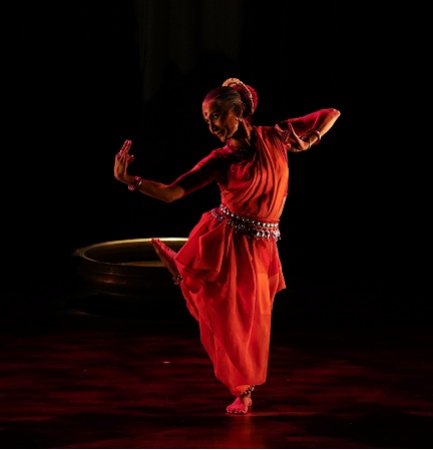 Bijayini Satpathy 'Contrast' is vital to the Indian traditional dance forms. Its impact however depends on the virtuosity and aesthetic acumen of the dancer. Odissi dancer Bijayini Satpathy's recital titled 'Call of Dawn' began with the visual interpretation of Adi Sankaracharya's Ardhanareeswara sthothra in which the dancer effortlessly switches from lasya to thandava and back. The images of Lord Siva and his consort Parvathi come alive in the minds of the viewers through the striking visual phrases created by the dancer. We get glimpses of Lord Siva's third eye turning Kamadeva into ashes and goddess Ganga ensconced in his tuft. The dancer powerfully portrays the serpents adorning his body and the limbs and her visualization of 'digambaraaya' is simply superb. The notes of the raga, Ahirbhairav, do carry a devotional and spiritual flavour. The bhava laden singing of the verses augments the picturesque movements and the expressional density of the dancer. Thus a young girl, witness to the god and the goddess in their divided and united appearance, emboldens her to express the power and sensuality of her being. With the continuance of the same raga, Bijayini moves on to the second item, Ahirini, based on the lyrics of the rebel poet, Kazi Nazrul. Here again the motif is 'contrast'. The dancer as the young lady has to make a choice between Krishna and Siva, 'accessible over intimidating, passionate over fierce, dark over radiant, the allurer over the forbidding'. A mendicant who passes by appeals to her as a sign and she decides to choose Krishna as her consort. Bijayini touches upon the rasavilasa of Lord Krishna side by side with the overwhelming presence of Lord Siva adorned by the Nagas exuding an irresistible luminosity. In the concluding item, Chakravaka Pallavi, the separation and anticipated reunion of the mythical birds forms a springboard for the dancer to revel in an almost non-textual dance. Music, vocal and instrumental, merges with the movements fluently to create the desired effect. The raga, Ahirbhairav, carries here a distinctive tone furthering the comeliness of the dancer. 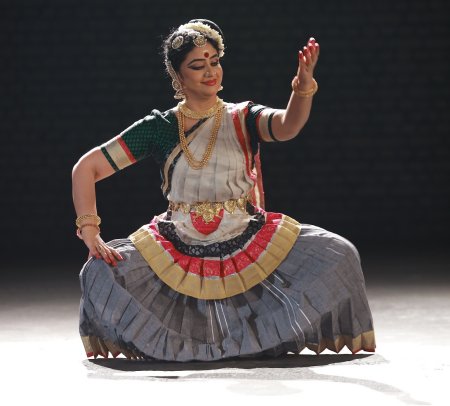 Methil Devika Mohiniyattam, the lasya dance heritage of Kerala, grew into prominence only in the closing decades of the last century owing to a host of socio-cultural factors. Several younger generation dancers have come up in the field either to revamp its rather wobbly tradition or to reinterpret it by means of intensifying its movement vocabulary and expressional terrains. Methil Devika is one of those talented dancers whose presentation of 'Ahalya' is quite a distinct treat for the viewers. Her portrayal of this strikingly sensitive character is based on lines chosen from Valmiki Ramayana. The melodious tone of the veena followed by akaaraalaapana provides the right ambience to begin the dance. The chollus to which Devika does the pure dance lends her movements a deshi charm. Her pakarnnaattam as Ahalya and sage Gautama is terse yet redolent in the sense that the spectators can easily identify with both the characters through their behavioural diversity. Devika persuasively portrays Lord Indra's arrival at the hermitage and his meeting up with Ahalya. The jubilant mood of the Nayika interspersed with lasya-laden movements is backed by the alluring cadence of the triputa tala. Raga Bhoopala transcends the atmosphere from impassivity to sensuality. The dancer admits that the undercurrent of sadness reflected in the raga is intended. Ahalya recognizing the true identity of Lord Indra disguised as Gautama is subtly but forcefully conveyed by the dancer. The flowers in full bloom and the peacock with its spread out plumes appearing in the dance portion that follows suggest Ahalya's amorous longings. Mizhavu is the percussion instrument used here, the tone of which obviously lacks gamaka. Maddalam would have been a better choice. Devika's visual narrative of Gautama's curse turning Ahalya into dust/stone, invisible to the world and her subsequent redemption by Lord Rama is compelling on all counts. Ahalya's unbearable solitude is nonetheless hard to be translated into any visual frame. The musical background in raga Punnagavarali for the entry of Lord Rama renders a divine aura to the entire scene. Raga Nattakurunji at the outset and the few lines in raga Sudhasanyasi, at a later stage, too contribute to the overall beauty of the recital. Honesty is the hallmark of Devika's performance. She doesn't go in for a gender-oriented political statement using Ahalya as a medium nor does she get involved in defending or defying the conventional morality associated with Ahalya's romantic instincts. Such interpretations have become trite. The dancer confines herself to the implications propounded in the Aadi kavya. What a relief! 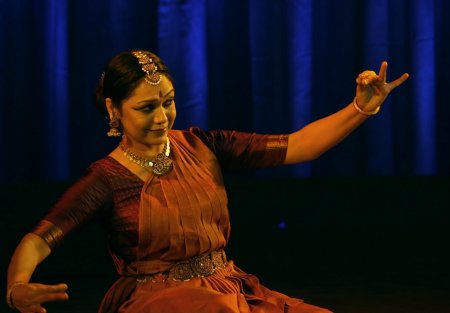 Rama Vaidyanathan An immaculate command over the language of Bharatanatyam is what makes Rama Vaidyanathan's performance a sheer visual delight. 'Moving boundaries' is her hilarious explorations in the expressional dynamics of the dance form beginning with the basics, Theyya theyi. It then progresses to tha thei thei tha and thi thei thei tha. Adavus bloom into multiple traits and the repeated execution of the theermanam - kita thaka thari kita thom - turns inexplicably vibrant. The geometrical exactitude of her movement vocabulary is unobtrusive in the sense that the dancer seldom overpowers the dance. "Aananda Aadarangam" (from Thirumular'sThirumandiram) is the lyric that prompts Rama to immerse herself into the boundless joy of dance. Rama moves on denoting the merging of all the boundaries.The dancer's vision of rediscovering her emotions and repossessing her intentions finds expression in what she does. The line, Adangaatha yennai adakki, is about the boundaries leading the way. As the song progresses towards thaanam, niraval and the swaras the dancer is seen very much in her elements. The spontaneity with which the dancer switches from one Nata to the other is remarkable. Sudha Raghuraman's evocative singing, especially her chiselled brigas, in the lower, middle and the higher octaves empowers the angikaabhinaya of Rama considerably. Rama then steps into metaphors like the flying kite, the raindrops, leaves and the dancing peacock to reinforce her zest as a dancer. These images are used to suggest that dance does not restrain but liberates the soul of all those who are into it. The dance rises far above the mundane and aspires for eternity.The finale does carry an unanticipated dramatic touch. The dancer returns to where she started! 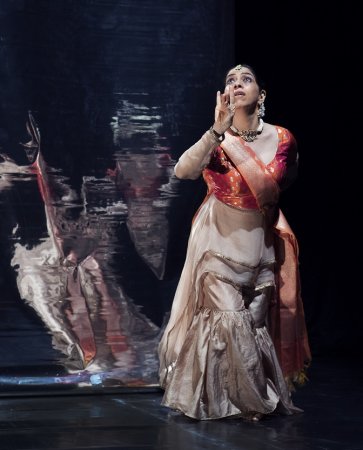 Aditi Mangaldas Even the most eminent dancers in the Indian traditional dance forms do carry within themselves a sense of insecurity as the so called intellectuals in our society inculcate in them a feeling that they have become redundant. This is an absurd notion since their constituency of admirers has been intact for decades. In case a dancer of this genre wants to deal with contemporaneity by means of her medium, it is definitely possible provided he/she does have a high degree of imagination and sensitivity apart from an unquestioned mastery over the dance form of his/her choice. Endowed with these distinctions, Kathak dancer Aditi Mangaldas' 'Lost in the forest' underscores the pandemic inflicted world as her dance 'breathes the air of the now'. Aditi gives expression to the acclaimed poet, Kunwar Narain's "River in the Boat". The title of the poem itself speaks volumes. By turning what is known and normal on its head, the poet mirrors the darkness that has engulfed us and the irrevocable constraints that ensnare our lives. The hollow frames moving in the wind, a disconsolate night, dark river, despondent life and a deep sense of loss are imageries created by the dancer to remind us of the predicament we have fallen in. Even the dancer herself emerges from darkness. Standing by the window, Aditi displays an enduring angst although a ray of hope flashes across her face once in a while. But it recedes as fast as it advances.She is bewildered by her own image. She laments in vain the loss of the river, the boat, the narratives and what not? Shubha Mudgal's soulful singing about the depth of night accentuates the ambience. Whatever the dancer's imaginative voyage, the defining characteristics of Kathak are not dispensed with. In the next item, the protagonist is the deer who comes across two moons; the real and the reflected. Aditi portrays the jubilant mood of the deer symbolized by the hand gestures and the multiple movements of the body and the limbs. Its awe and excitement at the sight of the two moons are easily discernible from the facial expressions of the dancer. 'Real is illusion or illusion is real?'The poem of Bharatendu Harishchandra is the stimulant that gives her the courage to say 'tomorrow is another day'. Watching the moon appearing from the clouds, the joy of the dancer as the deer knows no bounds. The fast-paced chakkars she does here are mind blowing. I am not competent to comment on the camera, the lighting and other technical aspects related to the stage setting. Yet, I could see the creative interventions of the camera as well as the lights in the presentation of Aditi. For the rest of the dancers, the same degree of involvement of both may not be indispensible. By and large all the four performances are spectacular in several respects viewed against the tough time we are confronted with. 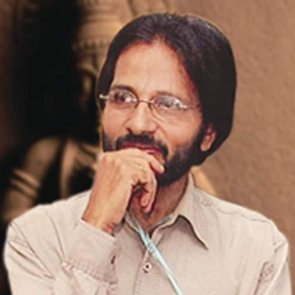 Former Deputy Registrar of Kerala Kalamandalam, V Kaladharan is also an art critic. He has published several articles at the academic level. 'From Meditative Learning to Impersonal Pedagogy' was published a couple of years back in an anthology 'Qui Parley' initiated and released by scholars and writers from the University of California, Berkeley. His articles on Indian performing arts and literature regularly appear in magazines and journals, and in the Friday Page of The Hindu. |